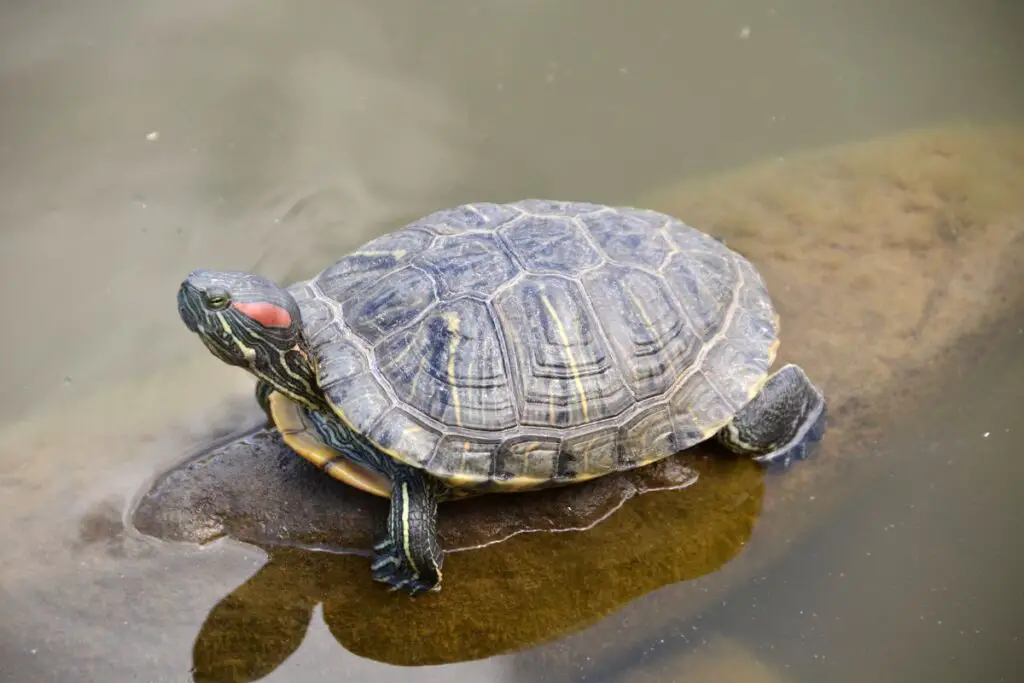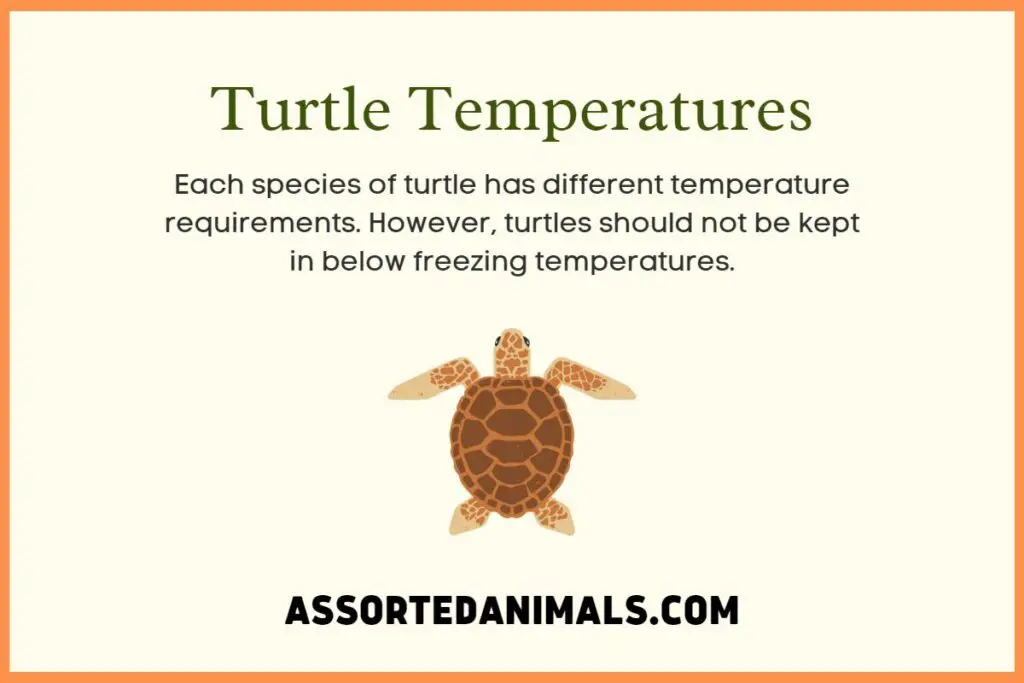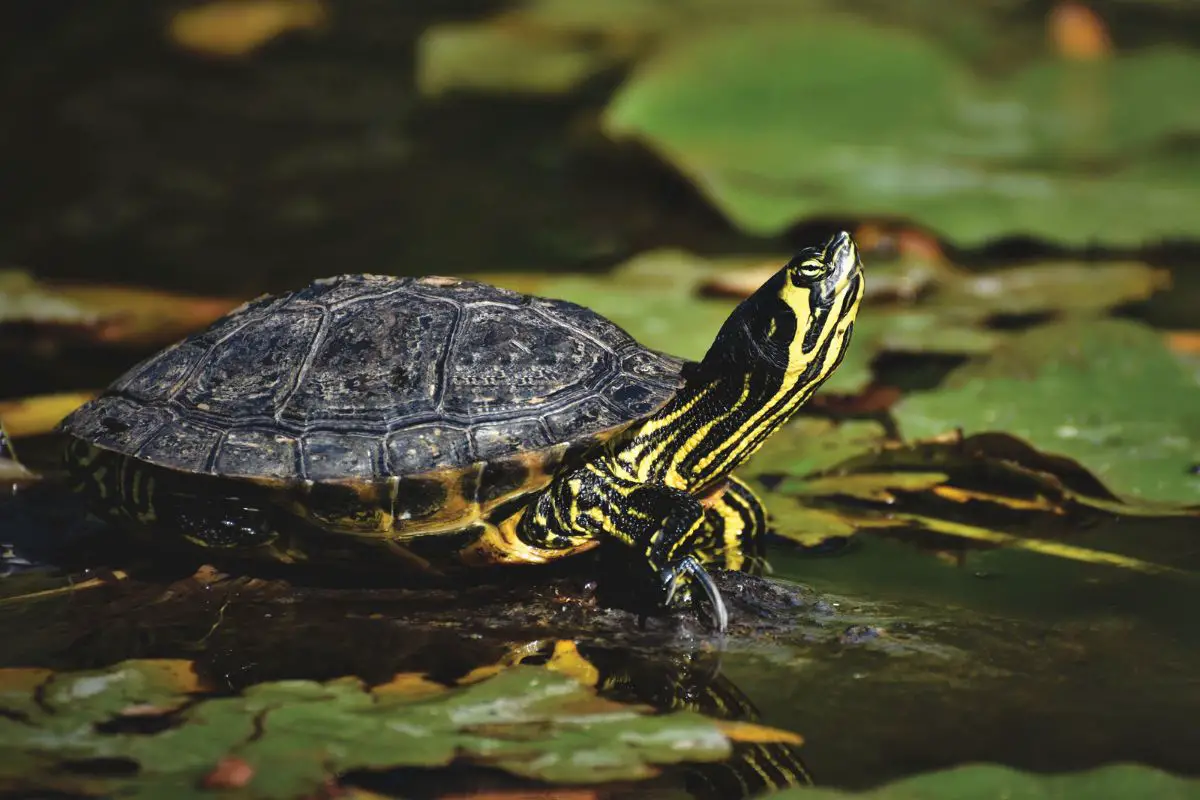When I think about turtles, I think about how slow-moving they are, how easygoing they seem to be (most of the time), and how they are resilient enough to survive in nature, even during winter.
We’re going to give you some examples of how to prepare turtles for winter, and how turtles in the wild manage to survive the winter months.
How Do Turtles Survive in the Winter?
In the winter months, turtles that are freshwater will go down deep into the waters of ponds, lakes, and sometimes streams, to bury themselves in the mud. During this time their metabolism slows down, allowing them to go months without food and very little oxygen in a process called brumation.
Nature has a way of providing everything animals need. Even when things are changing around them. Their biology allows them to slow things down enough to conserve energy and keep them safe during those cold winter months.
Do turtles hibernate in the winter? Turtles do not fully hibernate. They save up their energy, slow down their metabolism, and go into a semi-deep sleep state called brumation.
Pet turtles can also go into this semi-hibernating state, however, if you keep the temperatures warm enough, and feed them regularly, they will avoid going into brumation, which is also acceptable.

Do Turtles Sleep All Winter?
Turtles are semi-hibernators. They function a little differently than other animals that hibernate. Most animals that go into full hibernation go into a deep sleep, while turtles go into brumation, where their metabolism slows down, causing them to eat less, but not fully go to sleep.
Many turtle species go into this semi-hibernation in October and November and it can last all the way to March, in some cases. During this time they will be mostly inactive, but will not be sleeping the entire time the way other animals who are true hibernators do.
What Do Turtles Do in Cold Winter?
In the cold winter, wild turtles go to the bottom of their ponds and bodies of water. Down that low, there is more oxygen and the temperature is slightly warmer.
Animals that fully hibernate drop their body temperatures to almost freezing temperatures, however, turtles do not.
They stick themselves into the mud where the temperatures are above freezing. Their metabolism slows down and at this stage, they are able to go without food for long periods.
They do not eat during this period, they use the fat that they have stored up. They can still move around a little and they are able to absorb oxygen through tissue in different parts of their body.
Want to know more about turtles? Check out How Long Can Turtles Go Without Eating
Can Turtles Stay Alive if Frozen?
Turtles cannot stay alive if they are frozen. If the temperatures get below freezing the ice crystals that form are deadly for a turtle. They must be able to absorb oxygen from the water, and the ice crystals prevent that.
While there are some creatures such as certain types of frogs, that can be frozen, and still live, turtles are not one of them. Turtles that live in the wild are at the mercy of the weather and conditions of their environment.
They instinctually know that they need to go deep down into the water, where it is warm enough for them to survive the winter.

What is the Coldest Temperature a Turtle Can Survive?
Turtles, like box turtles, cannot survive in temperatures below 60 degrees, however, painted turtles can survive temperatures as low as 37 degrees. Let’s take a closer look at the coldest temperature a turtle can survive by species.
| (Types of Turtles) | How Cold Turtles Can Survive |
| Snapping turtle | 40 degrees |
| Painted turtle | 37 degrees |
| Red-eared slider | 50 degrees |
| Spotted turtle | 70 degrees |
| Eastern box turtle | 60 degrees |
| African sideneck turtle | 70 degrees |
| Yellow-bellied slider | 51 degrees |
| Western painted turtle | 37 degrees |
| Common musk turtle | 70 degrees |
| Mississippi map turtle | 60 degrees |
These temps are the worst-case scenario for turtles in the wild and as pets. Your turtles should never be exposed to temperatures below those on the chart above.
You should make sure that you research the exact temperatures that your turtles need to be at to be healthy and happy.
Do Turtles Need a Heater?
If you are raising pet turtles, there are different sets of rules for each type of turtle. For one, you do not have to put your turtle into hibernation mode, they can be kept on the same schedule as they always are and avoid brumation.
However, if you do decide to let them hibernate you need to follow a set of rules that will help them survive the process. For this to happen, the temperature needs to fall to around 50 degrees. To start, the turtles need to be healthy with no illnesses, and they need to be adults, not juveniles.
Once you have prepared them for the brumation process, they will need to have enough heat to keep from getting too cold. If they are kept in a location that gets freezing temperatures without a heat source, they would most likely die.
You should consider having a water-heating element as well as a light source for your turtles if you are keeping them inside for hibernation in cold areas.
Found this information interesting? Check out What Eats Turtles: Turtle Predators
Will Cold Water Hurt Turtles?
Water that gets to almost freezing temperatures or below can hurt turtles. In the wild, they know that they need to go to the deep waters of the pond and bury themselves where it is a little warmer.
If you have a pet turtle, and you let the water get to these damaging temperatures your turtle could become slow and lethargic, and could even die. The water should never get to the point where it creates ice crystals.
How Do Turtles Breathe in the Winter?
Just like most creatures, turtles have lungs and have to breathe. However, this is where it gets interesting. Turtles have adapted to being able to breathe through their skin.
The skin doesn’t breathe, however, it diffuses the oxygen by passing over the skin and blood vessels. During hibernation/brumation, turtles need less oxygen. The water passing over their pores is enough to diffuse the oxygen and sustain them with a process called cloacal breathing.
Interestingly enough the area of their body that uses this process the most is their butt. That’s right, turtles can breathe through their butt! Well sort of.
Can I leave My Turtle Outside in the Winter?
Turtles live outside in the wild. So yes, you could leave your turtle outside in the winter, as long as the conditions are right. You would not leave them outside in the winter in a place where the climate is not similar to the climate they need to survive.
A place that gets into sub-zero temperatures is no place for a turtle to be left outside. They are amazing creatures who adapt to survive, but ice crystals mean certain death for turtles.
Want to learn more about turtles? Check out Small Types of Turtles
Also, check out Do Turtles Have Tails?
Final Thoughts
Turtles are adaptive creatures that continue to push the limits of what it takes to survive in the wild.
For you pet turtle owners out there, the best thing you can do is learn as much as you can about your type of turtle and the conditions they require.
In the wild, turtles have to deal with the winter weather which their bodies are equipped to handle in the right locations.
Pet turtles can also handle the winter outdoors and indoors as long as they have the right climate and environment.
- Hero Farm Dog Survives Epic Battle with Coyote Pack - December 9, 2024
- The 10-Minute Bedtime Routine That Changed My Dog’s Sleep Forever - November 29, 2024
- Creating a Safe Space for Nervous Pets: Your Guide to Pet-Friendly Havens - November 25, 2024

